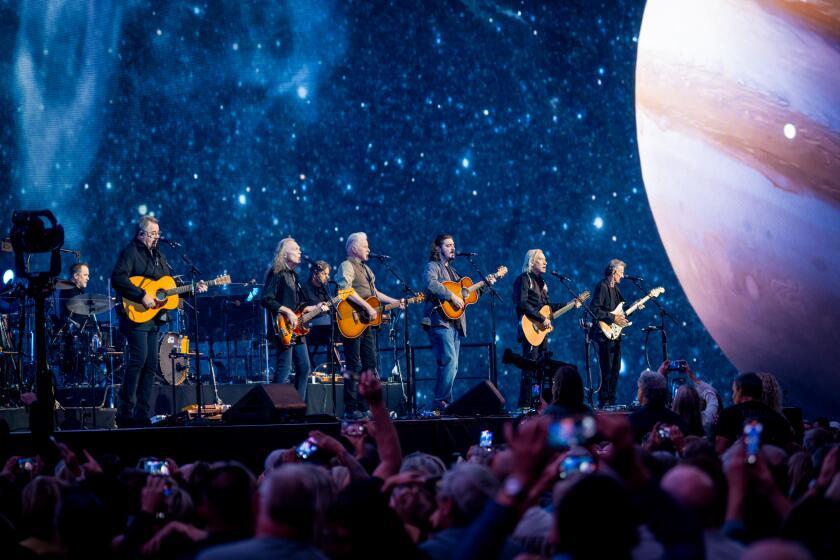The Woodstock of soul
Three decades after its debut, the groundbreaking concert film âWattstaxâ will be re-released Friday, with its original âlostâ ending restored -- a culminating performance by Isaac Hayes, filmed under stadium lights before a packed, nearly all-black L.A. Coliseum audience.
The 1973 movie, by Oscar-nominated director Mel Stuart (âWillie Wonka and the Chocolate Factoryâ), provides a candid, sometimes joyous, often disquieting window to a moment in African American cultural and political life, particularly in Watts some seven years after the riots, that anticipates the tumult that would re-erupt on many of the same streets in 1992.
For the record:
12:00 a.m. June 7, 2003 For The Record
Los Angeles Times Saturday June 07, 2003 Home Edition Main News Part A Page 2 National Desk 4 inches; 143 words Type of Material: Correction
âWattstaxâ -- An article in Thursdayâs Calendar Weekend on the re-release of the concert film âWattstaxâ contained several errors. A photo caption dated the concert as 1973; it took place in 1972, while the concert film was released in 1973. The first word in the title of the film âWilly Wonka and the Chocolate Factoryâ was misspelled as âWillie.â The story said that the filmâs band âincluded musicians Al McKay and Verdine White, who would become founders of Earth, Wind & Fire.â Verdine and Maurice White and others had formed EWF in 1969; McKay joined in 1972 after the original lineup disbanded and the Whites reorganized the band. Johnnie Taylorâs name was misspelled as Johnny. The R&B; group is the Staple Singers, not the Staples Singers. Blues musician Albert King was among the performers, not Freddie King, whose first name was misspelled Freddy.
Actor-director Ted Lange (âThe Love Boat,â âThe Redemptionâ) is one of the then-unknown voices in the film. âThe place was packed; it was like a picnic, an all-day affair. There was a wonderful camaraderie in the audience and I think the film captures that.... It was the black Woodstock, in a sense that Woodstock was what the white hippie deal was, and âWattstaxâ was the black soul version of a similar thing.â
Tickets were 99 cents. Proceeds benefited a trio of African American causes, including the Sickle Cell Anemia Foundation, the Martin Luther King Hospital and the then-burgeoning Watts Summer Festival, founded by Watts native Tommy Jacquette and curated by Los Angeles Living Cultural Treasure Cecil Fergerson, also a Watts native. The six-hour concert was the final event of the weeklong summer festival and featured appearances by dozens of now-recongizable figures, including Melvin Van Peebles (âClassified X,â âLe Conte du Ventre Plein,â) Jesse Jackson, Richard Pryor, the Staples Singers, Freddy King and more than 40 acts from Stax Records.
Al Bell, then president of Stax, recalls how the project began with a phone call 31 years ago. Stax L.A. office head Forest Hamilton, also a Watts native and son of famed jazz percussionist Chico Hamilton, suggested that Stax fund a benefit concert to âhelp the people of Watts, and give our artists exposure in Los Angeles,â Bell recalls.
To head the coordination of the concert and film, Bell turned to his vice president of marketing, the late Larry Shaw. Stax had entered the movie business the year before as distributor of Melvin Van Peeblesâ âSweet Sweetbackâs Baadasssss Song,â which ushered in a prolific period of black filmmaking.
Hamilton arranged for Bell to meet with the most recognizable name in documentary filmmaking, David L. Wolper, whose preferred director turned out to be Mel Stuart. But by selecting the white Stuart, Bell found that, initially, âwe had a lot of educating to do, because they hadnât been around black folks; that was quite an experience for them.â As Stuart recalls, âIt opened my eyes to a world that I was absolutely unfamiliar with.â
An aerial shot of the famous Watts Towers on East 107th Street opens the film with the R&B; hit âWhatcha See Is Whatcha Get,â by the Dramatics, providing both political commentary and soundtrack for a Stuart montage spanning 300 years of African American struggle and achievement in the U.S.
Stuart hired a crew that included 45 African American technicians. Among those receiving their first major film credits were Roderick Young (âBush Mamaâ) and Larry Clark (âPassing Throughâ). Emerging Mexican American cinematographer John Alonzo (âLady Sings the Blues,â âChinatownâ), who died two years ago, served as supervisor of photography. The filmâs band, borrowed from Van Peeblesâ âSweetback,â included musicians Al McKay and Verdine White, who would become founders of Earth Wind & Fire.
After he had reviewed the raw footage of the six-hour concert, Stuart was disappointed. He told Bell and Shaw, âWhat weâve got is a concert -- a newsreel of a concert. Itâs not good enough.... What Iâd like to do is go out into the streets with our crews and get how people feel about the issues of the day, particularly how itâs related to the music: gospel, blues, jazz and so forth.
âWe took 12 four-man crews,â he continued, âand we got what I think are some of the great interviews of the time about how African Americans felt about themselves and about the society around them. Not the very rich blacks, not the very poor, but just the average working person, and thatâs important.â
Stuartâs crews conducted interviews in barbershops, beauty parlors, in living rooms and on the streets of Watts. Next, he staged âmusical interludesâ with artists in characteristic environments -- Johnny Taylor in a packed, sweaty Crenshaw dive, and the Emotions in a humble Watts chapel, pouring their hearts into a rendition of the late Rev. James Clevelandâs âPeace Be Still.â
The new footage still wasnât enough for Stuart, who felt that âwhat we need is someone who sets up all the scenes. So Larry and Forest took me down to this club way down in Watts and they said, âWe have this guy and we think heâs pretty good.â So we walk in, and Richard Pryor is in this funky little club on this little stage.
âThis is how it went,â Stuart recalls. âPryor is at the end of a bar in this little club, and Iâd say, âGospel!â and heâd give me a half an hour on gospel. And OK, âBlues!â and âWomen!â and the guy would give you a half-hour off the top of his head. Unbelievable.â
Stuart had to re-shoot Isaac Hayes for the filmâs final segment after MGM, which was feuding with Stax, forbade him to use Hayesâ performance of his Oscar-winning âTheme From Shaft.â To get around this, Stuart and cinematographer Alonzo filmed Hayes against a black background on a soundstage. âHe wrote a new song for me called âComing Down From the Mountaintop,â â Stuart says, âand that was in the picture up until this time. When Saul Zaentz got the rights to the music of Stax, he was able to go back in and they found the piece that I actually did at the concert.â
The restoration, supervised by film restorer-editor Thom Christopher (the âStar Warsâ trilogy) was done in collaboration with the filmâs distributors, Sony Pictures Entertainment, Warner Bros. and Zaentzâs Fantasy Inc. Stuart, the recipient of four Emmys, a Peabody and an Oscar nomination, rates âWattstaxâ as one of his two greatest achievements. âThe first oneâs âWillie Wonkaâ ... and the second one is âWattstax.â â
The great thing about âWattstax,â â Lange says, âis you caught a moment in time, of what black people feel.â
*
âWattstaxâ
When: The film opens Friday.
Where: ArcLight Cinemas, 6360 Sunset Blvd., Hollywood, (323) 464-4226; and Magic Johnson Theaters, Crenshaw Plaza, Baldwin Hills, (323) 290-5900.
More to Read
The biggest entertainment stories
Get our big stories about Hollywood, film, television, music, arts, culture and more right in your inbox as soon as they publish.
You may occasionally receive promotional content from the Los Angeles Times.










